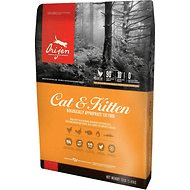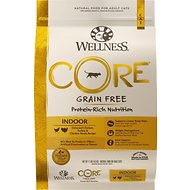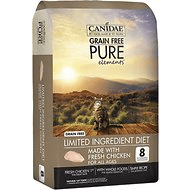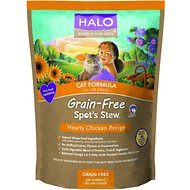Best Low Glycemic Cat Food
Quick Guide
If you or a loved one suffers from diabetes, you probably already understand the effects of food on blood sugar levels in the body. Even if you don’t know anyone with diabetes you have probably experienced a sugar high after eating a candy bar or a sugary snack – you may have also experienced the crash that typically follows a sugar high. This cycle can lead to metabolic stress and the development of diabetes in humans (especially when paired with overweight or obesity) but many pet owners do not realize that the same thing can happen to their cats.
The type of pet food product you choose for your cat has a direct influence on his health and wellbeing. Your cat doesn’t have the same freedom that you do to choose what he eats, so it is your responsibility to choose a product that will meet his nutritional requirements. In choosing a product for your cat you need to keep his basic nutritional needs in mind while also considering certain factors like the glycemic level of the ingredients. Below you will learn more about what the glycemic index is and whether you should be looking for a low glycemic cat food for your cat.
What is the Best Low Glycemic Cat Food?
What is the Glycemic Index?
The glycemic index is a numerical index that ranks the degree to which certain foods affect blood sugar levels. When your cat eats food, his body breaks down the ingredients into their most basic component – glucose – which is then absorbed into the bloodstream and transported throughout the body as a source of energy. Some foods are digested more quickly than others which means that they have a more immediate effect on your cat’s blood sugar levels – these are referred to as high-glycemic foods. Low-glycemic foods are those that have a more limited effect on your cat’s blood glucose levels because they are digested and absorbed into the bloodstream more slowly.
The glycemic index ranks foods on a scale from 0 to 100 with high-glycemic foods being ranked closer to 100 and low-glycemic foods being ranked closer to 0. Understanding the glycemic index is important when choosing a quality cat food product for your cat because you want to limit the amount of high-glycemic ingredients that go into his food. Your cat’s body works best when his blood sugar levels remain fairly constant. If he eats too many high-glycemic foods, it can cause dangerous spikes in blood sugar levels which could trigger his pancreas to produce extra insulin. The extra insulin will help to reduce your cat’s blood sugar levels but, in doing so, it will convert the extra sugars into stored fat which can increase your cat’s risk for obesity and for type 2 diabetes. When your cat’s blood sugar levels spike quickly, the extra insulin has a tendency to then drive his blood sugar levels to a dangerous low shortly after. This cycle is very dangerous for your cat.
Low-Glycemic Ingredients to Look For
Carbohydrates are given glycemic index ratings based on the degree to which they impact blood sugar levels. Complex carbohydrates like whole grains and certain starchy vegetables are generally considered low-glycemic foods because they are digested and absorbed by the body more slowly than simple carbohydrates. Simply carbohydrates include things like refined sugars and processed grains and they tend to cause those dangerous spikes in blood sugar that you’d like to avoid for your cat. Understanding the difference between complex and simple carbohydrates is important if you are looking for a low-glycemic cat food. Below you will find an overview of some low-glycemic ingredients to look for when you start shopping for a new cat food brand:
- Avocado
- Broccoli
- Cauliflower
- Kale
- Spinach
- Tomatoes
- Carrots
- Green Peas
- Winter squash
- Apples
- Berries
- Cranberries
- Flaxseeds
- Almonds
- Pumpkin seeds
- Sunflower seeds
- Chickpeas
- Dried beans
- Lentils
- Barley
- Brown rice
- Oats
- Quinoa
- Millet
In addition to these fruits, vegetables, nuts, seeds and carbohydrates which are low on the glycemic index, all meats, poultry, and seafood are naturally low-glycemic as well. This is why high-protein cat foods also tend to be low-glycemic cat foods, unless of course they also contain high-glycemic ingredients like corn, wheat, and soy. As a general rule, however, you want to avoid corn, wheat, and soy ingredients because they offer very limited nutritional value for your cat and they are also fairly likely to trigger food allergies or sensitivities.
Should You Switch to a Low-Carb Cat Food?
If your cat has diabetes or issues with his blood sugar levels, you may be considering a low-carb cat food. What you may not realize, however, is that low-carb cat foods can be good for all cats – not just cats with diabetes or blood sugar issues. The fact of the matter is that cats are obligate carnivores and their bodies simply are not adapted to digesting plant materials very efficiently. Not only can high-glycemic carbohydrates cause your cat’s blood sugar levels to spike, but they can also induce digestive problems. Cats with digestive issues often experience secondary health problems like nutritional deficiencies since their digestive systems are not able to effectively digest and absorb nutrients.
Rather than focusing on finding a low-carb or low-glycemic cat food for your cat, you may instead want to look for high-protein formulas. Because cats are obligate carnivores, their bodies are adapted to derive the majority of their nutrition from animal products. In the wild, cats consume live prey which consists primarily of raw meat, organs, and raw bone – any carbs they consume likely comes from the stomach contents of their prey and it has already been partially digested. To help keep your cat’s blood sugar stable while also meeting his nutritional needs, choose a high-quality cat food formula that provides high levels of animal protein with moderate levels of animal fat and low carbohydrate content.
Tips for Choosing a High-Quality Cat Food
The first thing you should do when evaluating the quality of a low-glycemic cat food is to look for the AAFCO statement of nutritional adequacy. The American Association of Feed Control Officials (AAFCO) is responsible for setting and enforcing the standards for quality and safety of animal feed and pet foods that is produced in the United States. AAFCO has created nutrient profiles based on the minimum nutritional requirements for pets in different life stages (adult maintenance or growth) and commercial cat foods are compared to these nutritional profiles before being sold. If the product meets the basic requirements, it will carry an AAFCO statement of nutritional adequacy that looks something like this, “[Product Name] is formulated to meet the nutritional levels established by the AAFCO Cat Food Nutrient Profiles”. Do not buy a product that doesn’t carry this statement because it won’t meet your cat’s nutritional needs.
After determining that the product is complete and balanced for cats, you still need to take a closer look at the label – just because the product meets the nutritional needs of cats doesn’t mean that it is a quality product. Take a look at the guaranteed analysis for the product to determine the total values for crude protein, crude fat, and crude fiber. Here you want to see the protein and fat values fairly high but the fiber value should be fairly low – ideally less than 5%. The guaranteed analysis is a good tool to use when making a direct comparison between two dry cat foods. Remember, protein is the most important nutritional consideration for cats which is why you want this value to be high. Fat is the most highly concentrated source of energy available for cats, so you want this value to be fairly high as well. The average moisture content for dry cat foods is usually around 10% and fiber levels can vary but, again, you want that value to remain fairly low if you are looking for a low-glycemic cat food.
Finally, after checking for the AAFCO statement of nutritional adequacy and after checking out the guaranteed analysis you need to examine the ingredients list in order to judge the quality of the product as a whole. As a general rule, you don’t want the ingredients list to contain more than 20 ingredients or so. Cat foods that have ingredients lists a mile long generally do so because they are made with low-quality ingredients and the company has to fortify the recipe with artificial additives and supplements to restore nutritional value. You want to see a high-quality protein (fresh meat, poultry, seafood, or a named meat meal) at the top of the list – no exceptions. You also want to see at least one source of quality animal fat (like chicken fat, salmon oil, or other fish oils) near the front of the list. Plant-based fats aren’t necessarily bad for your cat but animal-based sources are more biologically valuable.
When it comes to the carbohydrate content of the cat food, you need to be especially careful in checking the ingredients list. Remember, simple carbohydrates like wheat, corn, refined sugar, and processed carbohydrates are high-glycemic foods so you want to avoid them. You should also avoid any product that lists a carbohydrate as the first ingredient – even if it is a quality carbohydrate. Look for a product that utilizes gluten-free and grain-free carbs like sweet potatoes, peas, lentils, and tapioca or one that focuses on low-glycemic grains like whole grain brown rice, whole grain oats, quinoa, or millet. Again, you want the total carbohydrate content of the product to be fairly low so avoid any cat foods that make heavy use of carbohydrates, even if they come from quality sources.
In addition to paying attention to what ingredients are included in your cat’s food, you also need to be mindful of which ingredients are NOT included. You have already learned about the dangers of corn, wheat, and soy ingredients for triggering blood sugar spikes in your cat but there are other ingredients that offer low nutritional value or which can be harmful for your cat. For example, you want to avoid any cat food that makes heavy use of by-products – these ingredients do not necessarily come from low-quality sources but most pet food manufacturers do not tell you where they come from so you cannot judge the quality of the ingredient. You also want to avoid unnamed protein sources like “poultry meal” or “meat meal”. Again, these ingredients can potentially come from low-quality sources. Finally, avoid products that make heavy use of artificial flavors, colors, or preservatives as well as chemical-sounding additives that are not vitamins or minerals.
Top Recommended Low-Glycemic Brands
If you are concerned about your cat’s blood sugar levels, the best thing you can do for him is to choose a high-quality cat food product that will help to keep his blood sugar stable. The key to stable blood sugar levels is a quality diet made primarily of animal proteins and fats (naturally low-glycemic foods) with limited carbohydrate content. To help you choose a low-glycemic cat food for your cat, consider one of the top-rated cat food brands reviewed below.
Smalls for Smalls Fresh Beef Minced

Smalls for Smalls creates human grade recipes specially formulated based on a profile you fill out when you sign up. The food is delivered to your doorstep, which is about as convenient as it gets. Smalls for Smalls recipes are great for a low glycemic diet because they are high protein and contain very little carbohydrates. They also have no fillers or preservatives–only the things your cat needs and nothing more. Among the other benefits of fresh food are a shinier coat, more energy, and a less fragrant litter box. Cats are primarily carnivores, so they get most of their nutrition from the meat in their food. Smalls for Smalls recipes, such as the Fresh Beef Minced, are all protein first, so you know your cat is getting optimal nutrition during every meal. Another thing to think about is the fact that cats actually get most of their hydration from their food, as well. Smalls for Smalls Fresh Turkey Pate has a high water content, which means your cat will stay hydrated and healthy. If the ingredients aren’t good enough for humans, they aren’t good enough for cats, either, according to Smalls for Smalls, so when you subscribe, you know you are giving your cat food you can feel good about from a company you can trust.
Orijen Biologically Appropriate Cat & Kitten Food

The Orijen pet food brand sells “biologically appropriate” diets for cats and dogs. These products are designed based on the natural diets of wild cats and dogs. Not only do these products mimic the nutritional composition of wild diets, but they mirror the freshness and the variety as well. Orijen follows a Whole Prey philosophy of nutrition which consists of 70% to 85% fresh meat, 10% to 15% organ meats, and 5% to 10% edible raw bone. Not only does Orijen compose their formulas based on the Whole Prey philosophy to ensure quality and optimal nutrition, but they also source their ingredients locally wherever possible. The utilize quality proteins like cage-free poultry, ranch-raised meats, wild-caught fish and nest-laid eggs as well as sun-ripened fruits and vegetables in formulas that are complete and balanced, naturally.
When it comes to cat food products, Orijen offers three dry food options: Cat & Kitten, Six Fish, and Regional Red. All three of these recipes are formulated in keeping with the Whole Prey philosophy so they are naturally low-glycemic cat foods. The Cat & Kitten recipe features boneless chicken, chicken meal, and chicken liver as the top three ingredients with low-glycemic carbohydrates like red lentils, green peas, and pumpkin. The Six Fish recipe features 80% protein-packed fish like Pacific salmon, wild walleye, and northern pike as well as salmon oil, chickpeas, lentils, and an assortment of fresh fruits and vegetables. The Regional Red formula is made with black angus beef, heritage pork, and ranch-raised bison as well as lamb fat, red and green lentils, yellow peas, and herring oil. Overall, each of these three options offers plenty of high-quality protein and animal-based fats with limited carbohydrate content coming from an assortment of low-glycemic ingredients.
Wellness CORE Grain-Free Indoor Cat Food

The company known today as Wellness got its start in 1926 with the release of Old Mother Hubbard oven-baked dog biscuits. Over the following decades the company came to develop an assortment of quality pet food products featuring natural ingredients and home-style recipes. In the 1990s the brand was revolutionized with the help of a team of animal nutritionists and veterinarians which resulted in the creation of the Wellness brand. The first Wellness cat food recipes were released in 2000 and today the brand offers a wide variety of cat food products made with quality ingredients in healthy, holistic recipes that are free from corn, wheat, and soy ingredients as well as artificial flavors, colors, and preservatives. Wellness offers a line of original recipes in the Complete Health line of products as well as a line of grain-free products in the CORE line.
The Wellness CORE line of grain-free products includes many different options that are naturally low-glycemic. Each of these recipes is protein-focused and omega-rich to ensure complete and balanced nutrition for cats in all life stages. When it comes to dry food recipes, Wellness CORE offers four options – one kitten formula, one original formula, one indoor formula, and one recipe made with turkey, turkey meal, and duck. Because these recipes are protein-centered and grain-free, they are natural fairly low-glycemic. These recipes feature quality proteins like deboned turkey and chicken, chicken meal, whitefish meal, and other meats as well as animal-based fats like chicken fat and salmon oil. In terms of carbohydrates, these recipes rely on low-glycemic, complex carbohydrates like sweet potatoes, cranberries, and flaxseed. These recipes are also supplemented with dried fermentation products for healthy digestion and chelated minerals for optimal nutrient absorption.
Canidae Grain-Free PURE LID Cat Food

The Canidae pet food company was founded in 1996 as an independent, family-owned company and they remain that way today. This company set out with a commitment to creating high-quality, nutritious diets for pets using only the freshest natural ingredients. Canidae manufactures all of their own products at their Ethos Pet Nutrition facility located in Brownwood, Texas and they follow the strictest standards for quality and safety. Not only does Canidae use the best ingredients, but they source them from independent and family-owned businesses. Their recipes are focused around fresh meat, poultry and fish as well as wholesome fruits and vegetables. Canidae doesn’t use any corn, wheat, or soy ingredients in their products and their recipes are completely free from artificial flavors, colors, and preservatives. This company offers a wide variety of cat food products including the Canidae PURE line of grain-free products which are naturally low-glycemic.
Within the Canidae Grain-Free PURE line of products there are eight dry food options and eight wet food options. For adult cats there is the PURE Elements, PURE Sea, and PURE Stream recipe as well the PURE Ocean Indoor Cat Formula. There is one PURE recipe for hairball control, a PURE Meadow recipe for senior cats, and a PURE Foundations recipe for kittens. Each PURE formula is made with a limited number of ingredients starting with a quality animal protein. For grain-free carbohydrates, the Canidae PURE line of product relies on low-glcemic options like potatoes, peas, and sweet potatoes. Each formula is also supplemented with dried fermentation products for healthy digestion and chelated minerals for optimal nutrient absorption. Canidae Grain-Free PURE wet foods come in large 13-ounce cans or smaller 5.5-ounce cans and they too are all made with quality proteins and naturally low-glycemic carbohydrates.
Halo Grain-Free Spots Stew Dry Cat Food

The Halo brand uses the tag line, “purely for pets” and that is an accurate description of their products. Not only are their products made with pure, high-quality ingredients but they are designed with the nutritional interest of pets in mind. Halo was founded in 1986 and in the years since then they have rapidly gained in popularity and they are now known as one of the premier brands of holistic pet food products. Halo offers a number of promises to their customers, including a commitment to omitting chicken meal, rendered meats, and by-product meals from their products. They also promise natural recipes with added vitamins and minerals with no artificial flavors, colors, or preservatives. Halo products are all-natural, made from fresh, wholesome ingredients that are purchased from quality sources and they are combined in wholesome, balanced formulas for cats and dogs.
When it comes to low-glycemic cat food, Halo offers an assortment of grain-free options. There are ten dry cat food products divided between two product lines: Vigor and Spot’s Stew. The Vigor line of cat foods includes two grain-free recipes – Chicken, Turkey & Whitefish and Lamb, Turkey & Salmon. The Spot’s Stew line includes four grain-free options made with chicken, game bird, whitefish, and salmon. Halo’s Spot’s Stew line features home-style recipes made with quality proteins and other easy to recognize ingredients. Instead of using high-glycemic grains, Halo’s grain-free cat foods utilize things like whole peas, sweet potatoes, and fresh fruits and vegetables to provide dietary fiber and other essential nutrients. In addition to their dry foods, Halo also offers several grain-free wet foods such as Spot’s Choice Grain-Free Shredded Chicken Recipe, Spot’s Pate Grain-Free Wild Salmon Recipe, and Spot’s Stew Grain-Free Wholesome Chicken and Beef Recipe.
Now that you understand the glycemic index and the effects of high-glycemic foods on your cat you can understand the importance of choosing a low-glycemic cat food. It is important to remember that low-glycemic cat foods will not necessarily be labeled as such. For the most part, however, high-protein cat foods are low in carbohydrates and grain-free recipes tend to be fairly low-glycemic as well. You should always pay close attention to the guaranteed analysis and the ingredients list, however, to judge the quality of the product before you buy it for your cat.















